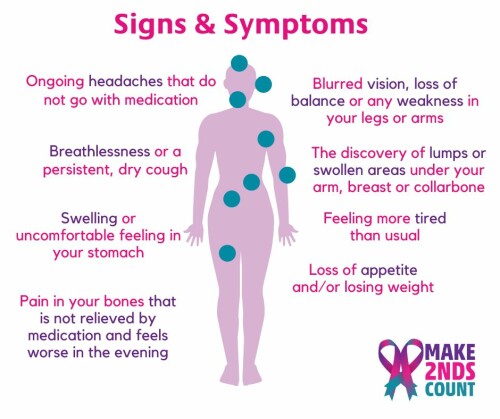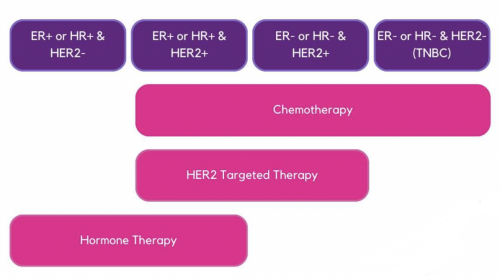Secondary (metastatic) breast cancer is a cancer that has spread beyond the breast to other parts of the body through the bloodstream or lymphatic system.
 There are an estimated 61,000 women and men in the UK living with this incurable disease, and symptoms can vary from person to person. It can be treated but not cured, with treatments aiming to control and slow the spread of the cancer down for as long as possible.
There are an estimated 61,000 women and men in the UK living with this incurable disease, and symptoms can vary from person to person. It can be treated but not cured, with treatments aiming to control and slow the spread of the cancer down for as long as possible.
Our vision at Make 2nds Count is to see our community living longer, better lives.
Misconceptions
Secondary breast cancer is often misunderstood by people as the 'second' time someone has had breast cancer. This is actually better known as a 'recurrence'. Secondary breast cancer is when it has spread (metastasized) from the breast to other parts of the body. It is also known as:
-
metastatic breast cancer
-
advanced breast cancer
-
stage 4 breast cancer
They all mean the same thing and it can be confusing when the disease is referred to in a number of ways.
How does the cancer spread?
The breast cancer cells can spread to other parts of the body through the bloodstream or lymphatic system. This process of spread is called metastasis and involves the following steps:

- The cancer cells break away from the primary tumour site and invade the nearby normal tissue.
- The cancer cells enter the blood or lymphatic system.
- The cancer cells travel through the blood or lymphatic vessels until they reach the target site, such as the bones, lungs, liver, brain etc.
- Once at the target site, the cancer cells leave the blood or lymphatic vessels and start to grow, forming secondary tumours.
Secondary breast cancer can be treated but it cannot be cured. Treatments aim to control and and slow the spread of the cancer for as long as possible, whilst giving the patient the highest quality of life.
Nearly 30% of women diagnosed with early-stage breast cancer will see their disease spread to other organs and develop secondary breast cancer, and this can sometimes be years after primary breast cancer. Our sites of secondary breast cancer page goes into this in further detail. There are also people who are ‘de novo,’ where the cancer has already spread at first diagnosis.
Spot the symptoms
 Secondary breast cancer can spread to multiple areas of the body. Because of this, there are a range of signs and symptoms to look out for. These will vary from person to person, so it is important that you listen to your body and talk to your GP as soon as possible if you develop any symptoms that are new, unexplained and persistent.
Secondary breast cancer can spread to multiple areas of the body. Because of this, there are a range of signs and symptoms to look out for. These will vary from person to person, so it is important that you listen to your body and talk to your GP as soon as possible if you develop any symptoms that are new, unexplained and persistent.
Our Signs & Symptoms page goes into further detail about each of these and you can hear from some of our community and their experiences.
Diagnosis
The main way secondary breast cancer is diagnosed is via the use of imaging and/or biopsies.
There are different subtypes of secondary breast cancer and understanding these classifications is important because they determine what treatment options will be available to you.
The main subtypes are based on the presence or absence of the hormone receptors (HR) oestrogen (ER) and progesterone (PR) and human epidermal growth factor receptor 2 (HER2). If none of these receptors are present your subtype would be known as Triple Negative breast cancer (TNBC).
Visit our diagnosis page to understand more about the different sub-types. 
Treatments
There are many different treatment options for secondary breast cancer. Each treatment hopes to relieve symptoms and control or slow down the spread of cancer for as long as possible, enabling the best quality of life. Treatment lines are determined by the oncology team with consideration of:
-
The type of breast cancer you have
-
How far it has spread and where
-
What treatments you have had so far
-
How quickly your cancer is growing
-
Your general health
Treatments can include hormone therapy, radiotherapy, chemotherapy and targeted biological therapies. For more information, visit our treatments page.
Clinical Trials are another treatment option, offering early access to new and improved treatments for secondary breast cancer. Our Clinical Trials Nurses offer a free and confidential opportunity to discuss clinical trials and they can do a personalised trial database on your behalf.
Find out more about our Clinical Trial Service and book an appointment to speak with our nurses today.
Living with secondary breast cancer
Getting a secondary breast cancer diagnosis can be mentally and physically gruelling for patients and those closest to them. In this section we have gathered together some resources to support you.
Having conversations with friends and family can be difficult. Here is a guide your loved ones may find helpful.
Patient Stories
There are many people living with secondary breast cancer who have shared their stories. These can be found on our Truth Be Told Page and the SBC and Me page. By reading about other people's stories, you may find similarities between other people's experiences and yours, this may put you at ease or grow a sense of community around you.
Life Expectancy
Life expectancy is difficult to predict as there are so many factors which can affect it. It can be dependent on subtype, how far the cancer has spread and the location(s) of spread.
However, with more research into new treatments, more people are living longer with a secondary breast cancer diagnosis.
Some people find it helpful to talk to their clinician for individual information about life expectancy. However, some prefer to not look at statistics or not to know.
It is important to know that there is no right way to live with secondary breast cancer and it’s ok to make your own path.
Support Available and Where to Find It
Make 2nds Count offers online support groups, virtual meet ups and classes: see the 2nds Together Facebook Group and Wellbeing Classes to find out more.
Our Tea & A Chat service offers a safe space for patients to meet and get peer to peer support in times of uncertainty. We also have a collection of online resources which may be helpful. To find groups and services available in your local area visit the 2nds Support Hub.

